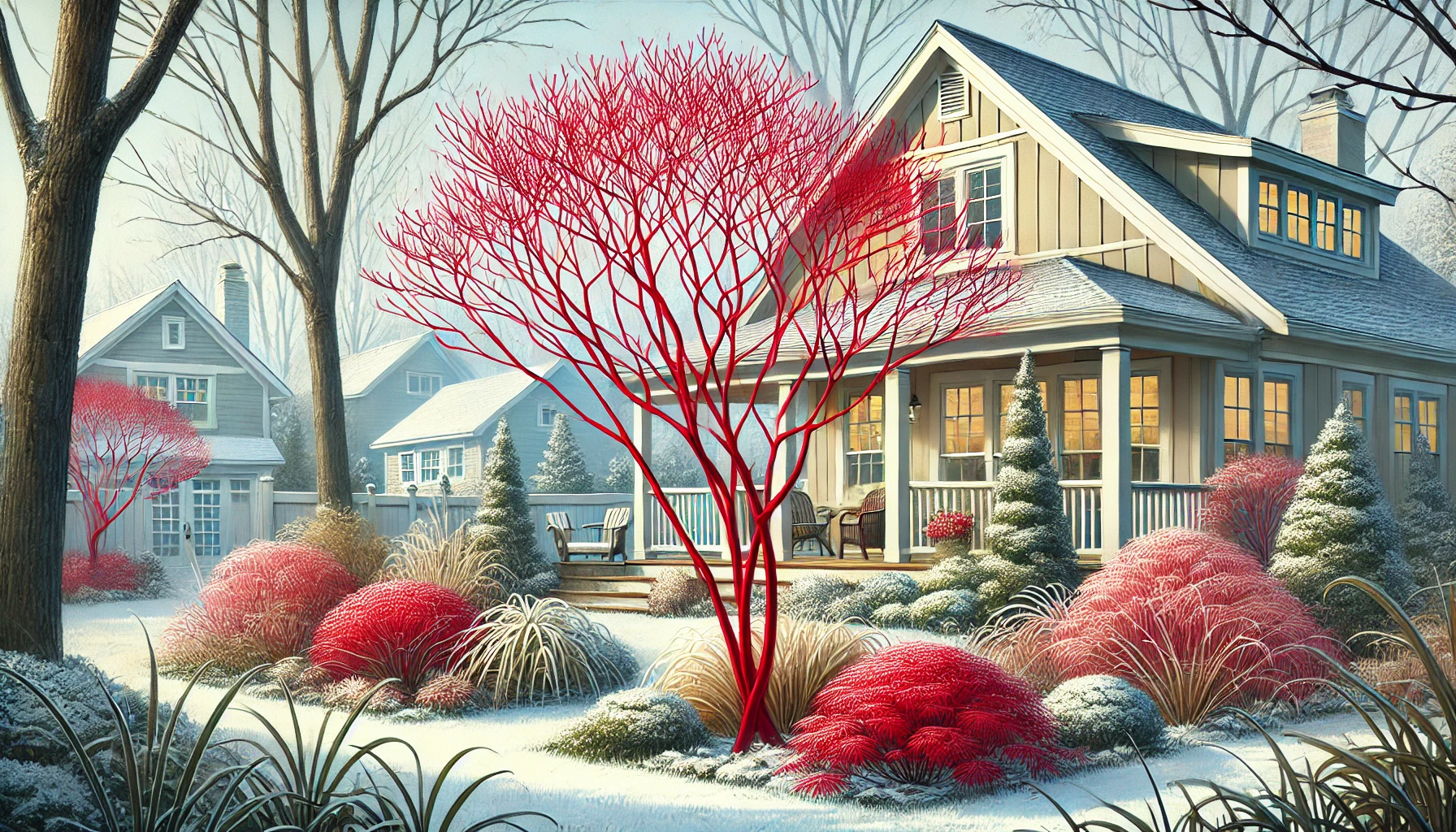
Red Twig Dogwood, formally known as Cornus sericea, is a perennial shrub known for its vibrant red stems that add color to winter landscapes. This hardy plant can grow up to 6-9 feet (1.8-2.7 meters) tall and wide, making it an excellent choice for garden borders and decorative plantings.
History and Ideal Growing Conditions
Native to North America, Red Twig Dogwood has been cherished for its striking appearance and versatility in various landscapes. Indigenous peoples used parts of this plant for medicinal purposes and basket weaving. Today, it is popular for its adaptability and vibrant color that livens up winter gardens.
Red Twig Dogwood thrives in USDA hardiness zones 2-8. It prefers moist, well-drained soil and can grow in a variety of soil types, from clay to sandy loam. It flourishes in full sun to partial shade, although full sun brings out the most vivid stem color.
Is Red Twig Dogwood Safe for Pets?
Red Twig Dogwood is generally considered non-toxic to pets. While ingestion of large quantities may lead to mild digestive upset, it is not known to be harmful. Still, it’s best to monitor pets around this plant.
Safe Alternatives for Pet Owners
For those seeking other pet-safe shrubs, consider:
- Butterfly Bush (Buddleja spp.)
- Ninebark (Physocarpus opulifolius)
- Forsythia (Forsythia spp.)
Best Practices for Caring for Red Twig Dogwood
Caring for Red Twig Dogwood involves providing the right conditions and routine maintenance to keep it healthy and vibrant.
Watering and Humidity
Water this shrub regularly, especially during the first growing season to establish its roots. Once established, it is moderately drought-tolerant but performs best with consistent moisture. During dry spells, water deeply to ensure the roots stay hydrated. Red Twig Dogwood tolerates average humidity levels.
Soil, Light, and Temperature
Red Twig Dogwood prefers moist, well-draining soil. It can adapt to different soil types, including clay and sandy loam. For the best results, plant it in a location with full sun to partial shade. It tolerates temperatures ranging from -40°F (-40°C) to 85°F (29°C), thriving in hardiness zones 2-8.
Fertilizing
Fertilize Red Twig Dogwood in early spring to support new growth. Use a balanced, slow-release fertilizer or a layer of compost to enrich the soil. Avoid over-fertilizing, as this can lead to weak growth.
Common Problems and Remedies
Red Twig Dogwood is generally hardy but may face some issues:
- Leaf Spot: Fungal infections may cause spots on leaves. Remove affected leaves and ensure good air circulation.
- Powdery Mildew: High humidity can cause this white fungal growth. Trim overcrowded branches and avoid overhead watering.
- Pests: Aphids and scale insects may appear. Treat infestations with insecticidal soap or neem oil.
Pruning Red Twig Dogwood for Vibrancy
Pruning Red Twig Dogwood not only shapes the plant but also encourages new, brightly colored stems. The best time to prune is late winter or early spring before new growth begins.
Tools Needed
Use sharp pruning shears or loppers. Always sanitize tools with a 70% alcohol solution before and after pruning to prevent disease.
Identify Areas to Trim
Focus on cutting back old stems to promote new growth. Remove up to one-third of the oldest stems each year to maintain a healthy, vigorous shrub.
Deadheading and Pruning Leggy Growth
Deadheading is not necessary for this plant. Prune leggy or weak growth to encourage a bushier shape and enhance overall appearance.
Remove Damaged or Diseased Leaves
Trim any damaged or diseased stems to prevent further issues and promote healthier growth.
Shape the Plant
Shape the plant by trimming stray or excessively long branches. This maintains an attractive appearance and prevents overcrowding.
Post-Pruning Care
Water the plant lightly after pruning to reduce stress. Avoid fertilizing immediately after pruning to let the plant recover naturally.
Propagation and Benefits
Propagate Red Twig Dogwood through hardwood cuttings in late fall or winter. Cut a healthy 6-12 inch (15-30 cm) stem, remove the lower leaves, and place it in moist soil. The vibrant stems add visual interest in winter, while the shrub provides habitat for wildlife year-round.
Final Thoughts
Red Twig Dogwood is a stunning addition to any garden, providing year-round interest and winter color. With proper care, pruning, and maintenance, this resilient plant will thrive and become a focal point in your outdoor space. Follow these guidelines to enjoy the beauty and benefits of the Red Twig Dogwood for years to come.



